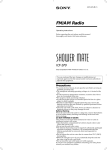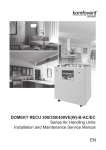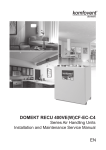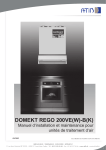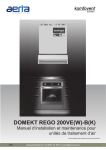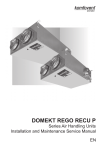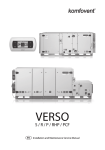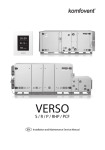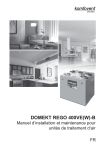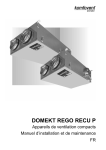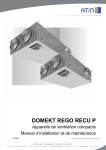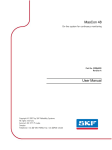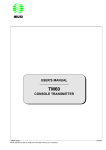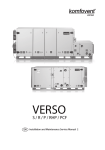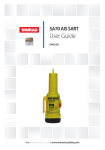Download DOMEKT REGO 400VE(W)-B
Transcript
DOMEKT ReGO 400VE(W)-B Series Air Handling Units Installation and Maintenance Service Manual EN Content Safety Requirements ...................................................................................3 Transportation ...................................................................................3 Brief Description of the Unit ...................................................................................5 Installation ...................................................................................6 Maintenance .................................................................................11 Technical Information .................................... ............................................13 Ordering Key .................................................................................15 This symbol indicates that this product is not to be disposed of with your household waste, according to the WEEE Directive (2002/96/EC) and your national law. This product should be handed over to a designated collection point, or to an authorised collection site for recycling waste electrical and electronic equipment (EEE). Improper handling of this type of waste could have a possible negative impact on the environment and human health due to potentially hazardous substances that are generally associated with EEE. At the same time, your cooperation in the correct disposal of this product will contribute to the effective usage of natural resources. For more information about where you can drop off your waste equipment for recycling, please contact your local city office, waste authority, approved WEEE scheme or your household waste disposal service. 2 Installation and Maintenance Service Manual Safety Requirements • To avoid accidents and/or unit damage, only a trained technician must carry out the connection. • The appropriate Personal Protective Equipment (PPE) attire is worn relative to the operation being carried out. • Electrical equipment is rated, connected and earthed in accordance with CE regulations. The air handling unit must be plugged in to an electrical outlet (with earth), which is in good order and corresponds with all requirements of electric safety. Before starting any operations inside the unit, make sure that the unit is switched off, and the power cable is unplugged. • • • • Earth must be installed according EN61557, BS 7671. The unit should be installed according to Installation and Maintenance Manual. Before starting the unit, check correct position of air filters. Service maintenance should be carried out only in conformity with the instructions specified herein below. • If main cable is damaged, only manufacturer, service team or trained technician must change it in order to avoid accidents. Transportation The air handling units are ready for transit and storage (1 Picture). The unit is packed to prevent damage of the external and internal parts of the unit, dust and moisture penetration. The unit is packed to box after that corners of the air handling units are protected against the damage – protective corners are used. The entire unit is wrapped up in protective film. For transit or storage, units are mounted on timber pallets. The unit is fastened to the pallet with polypropylene packing tape over protective corners. Air handling unit ready for transit and storage 1 Picture We reserve the right to make changes without prior notice. 3 Installation and Maintenance Service Manual Forklift truck or hand pallet truck can transport air handling unit as it is shown ( 2 a, b Pictures). Air handling unit transportation by forklift truck or hand pallet truck 2 b Picture 2 a Picture 2 a Unit is transported by hand pallet truck on a wooden pallet; 2 b Unit is transported by forklift truck on a wooden pallet. The unit should be examined upon receipt, to ensure that no visible damage has occurred during transit, and the advice note checked to ensure that all items have been received. If damage or delivery shortages are discovered, the carrier should be immediately informed. AMALVA should be notified within three days of receipt, with a written confirmation sent within seven days. AMALVA can accept no responsibility for damage by unloading from carrier or for subsequent damage on site. If the unit is not to be installed immediately, it should be stored in a clean, dry area. If stored externally, it should be adequately protected from the weather. 4 We reserve the right to make changes without prior notice. Installation and Maintenance Service Manual Brief Description of the Unit • The air handling units are intended for ventilation of small and medium-sized spaces (eg. single family houses, offices, etc.), having operating ambient temperature and relative humidity. The unit is intended to be installed in the kitchen or other domestic premises. Mineral wool is used for thermal insulation and sound attenuation. Units cover panels are 25 mm thick. As standard, the unit is designed for indoor placement. The operating temperature range for the unit is -300C ... 400C, outdoor air temperature. The air handling unit is not to be used to transport solid particles, even not in areas where there is a risk of explosive gases. • DOMEKT REGO 400VE(W) (3 Picture) series units are equipped with a rotary heat exchanger, air filters, an electric air heater, fans and automation control system, to ensure safe and efficient operation of the unit. • Before you open the door, the unit must be switched off and the fans must have been given time to stop (up to 3 minutes). • The unit contains heating elements that must not be touched when they are hot. • To maintain a good indoor climate, comply with regulations and, to avoid condensation damage, the unit must never be stopped apart from during service/maintenance or in connection with an accident. • If the unit is placed in spaces with high humidity, condensation might occur on the surface of the unit when outdoor temperatures are very low. DOMEKT REGO 400VE(W)-B Air Handling Unit Scheme D A B C C B E E A D 5 3 3 5 2 4 4 2 7 E1 E 6 A C B D C A D B 1. Rotary heat exchanger 2. Supply air filter 3. Exhaust air filter 4. Supply fan 5. Exhaust fan 6. Electric air heater * 7. Automation control system A. B. C. D. E. 3 Picture Outdoor intake Supply air Extract indoor Exhaust air Kitchen hood connection (by-pass – extraction without heat recovery) * AHU REGO-400VW-B is suitable for use with water duct air heater. Note: to reduce the noise level to the premises, it is recommended to install sound attenuators in the ducts. We reserve the right to make changes without prior notice. 5 Installation and Maintenance Service Manual Installation Unit Inspection Before installing the unit, inspection must be carried out. Unit has removable panels from its both sides (4 Picture). 4 Picture All internal unit components can be extracted from inspection side. After choosing desired inspection side, it is necessary to check if rotary heat exchanger, electric heater and automatics box are positioned correctly. Rotary heat exchanger and automatics box are maintained from inspection side. Picture 4 shows unit with left-hand inspection side. To get unit with right-hand inspection side, internal unit elements must be turned round. Remove both unit’s panels, which afterwards must be counterchanged to have possibility of other side inspection. Start with electric heater (5 Picture). After removing the cover of the electric heater, electrical connection with the rotor must be disconnected. unplug plug 5 Picture Taking off the switch from the unit it is needed to take it apart from each other and check if the contacts are fouled. 6 We reserve the right to make changes without prior notice. Installation and Maintenance Service Manual Afterwards electric heater may be extracted, turned round and put in by its other side (6 Picture). Then rotary heat exchanger and automatics box must be turned round being already disconnected from all connections and with unscrewed grounding wires (7 Picture). unscrew disconnect pull and screw 6 Picture 7 Picture Screw off and remove top covers of automatics and by-pass. Afterwards they must be counterchanged and screwed again (8 a, b Pictures). 8b Picture 8a Picture We reserve the right to make changes without prior notice. 7 Installation and Maintenance Service Manual Disconnect fans’ connections; pull out air temperature sensor together with a rubber plug. Loosen all wires fixed in the partitions with rubber gaskets and extract rotary heat exchanger (9 Picture). pull disconnect 9 Picture While unit casing is disassembled, all protective gaskets from the unit back side must be removed on its front one (10 Picture). Then assemble in inverse way to get the unit of opposite inspection side. 10 Picture Before inserting rotary heat exchanger, one by-pass cover which is located in it must be removed. Cover is unscrewed with six screws. This is done to have correct by-pass air flow direction. Opened vent must always be near exhaust flow fan (11 Picture). Note: There are two by-pass covers by default. When connecting the by-pass, one cover must be removed. 11 Picture 8 We reserve the right to make changes without prior notice. Installation and Maintenance Service Manual Insert rotor by its correct side; put on protective gaskets to their places (12 Picture). When changing inspection sides, be sure fans’ connecting plugs are not counterchanged. Fans are connected by the same connections. In case if unit is right-hand side, fans wires are crossed over in rotary heat exchanger’s electronics place. Also by crossing the wires, correct air temperature sensor position will be achieved. 12 Picture Then electric heater is connected (13 Picture), cables must be carefully connected and fixed to appropriate places. Do not forget to screw on grounding wires and make connections in indicated places. 13 Picture Picture 14 shows unit from right-hand inspection side. 14 Picture Do not forget to put on elements for hanging before screwing on back panel. Use the same instruction of changing the inspection side of AHU, but without the notes of electric heater. We reserve the right to make changes without prior notice. 9 Installation and Maintenance Service Manual The place for the unit should be selected with allowance for minimum access to the unit for maintenance and service inspection. The minimum free space in front of the inspection panel should be not less than 600 mm. It is recommended to install the air handling unit in a separate room (15 Picture). Unit brackets’ positions O125 O160 30 604 641 662 57 A B 30 300 15 Picture 600 Pictures 16 a and 16 b show unit’s upper and bottom fixing element. 9 1 2 3 4 5 8 7 6 2 16a Picture 1. Screw 4. Hanging bracket 2 7. Self tapping screw 2. Wall plug 5. Bolt M5 8. L-shape bracket 3. Hanging bracket 1 6. Gasket 9. 1 16b Picture Washer M5 DIN9021 Final Inspection After installation of the unit, a thorough inspection should be carried out. This should include inspecting the inside of the unit and removing debris and tools, which may have been left behind by on site contractors. Replace any panels, which may have been removed and close all access doors, ensuring that the door sealing gaskets have not been damaged. 10 We reserve the right to make changes without prior notice. Installation and Maintenance Service Manual Heating coil connection* and the pipe work should be done in order to ensure the space for maintenance and service work. When carrying out the installation of heater pipes, make sure that hot water supply is completely disconnected. Before start-up of the air handling unit, the heater system should be filled in with water. Glycol is used in the air handling units with coil heat exchanger. Never pour glycol down a drain; collect it in a receptacle and leave it at a recycling centre or the like. Glycol is highly dangerous to consume and can cause fatal poisoning or damage the kidneys. Contact a doctor! Avoid breathing glycol vapour in confined spaces. If you get glycol in your eyes, fush them thoroughly with water (for about 5 minutes). *If water heater build in. When operating air handling unit in the temperatures lower than 0°C, it is necessary to use glycol additionally or assure the reversible heating agent temperature more than 25°C. It is important to maintain air heaters and coolers cleanliness; that is to change filters installed in the air handling unit on time. If the air heater or cooler gets dirty, to perform periodical cleaning. Maintenance It is recommended to carry out routine maintenance of the air handling unit KOMFOVENT DOMEKT REGO 400VE(W) 3 – 4 times per year. Extracting unit elements (see 17 Picture). Cables must be disconnected when extracting electric heater and rotary heat exchanger. 17 Picture During inspection, the following operations should be performed: 1. Rotary heat exchanger check. Inspection of the rotary heat exchanger is performed once per year. Free rotation of the rotary heat exchanger, continuity of the rotating belt, absence of damages of the rotor drums and the seal gasket are checked. It is necessary to check the stretch of belt. Free belt will slide and the efficiency of rotary heat exchanger will fall down. To reach maximal efficiency, rotor must turn at least 6 times per minute. Polluted heat exchanger will decrease efficiency. Cleaning can be performed by compressed air or soapsuds. Check out water falling on the rotor’s electric motor. Rotor cleaning. If rotor cleaning by compressed air is not effective, it can be washed with soapsuds (18 Picture), or if needed – use degreasing soak for metal (aluminum) cleaning. Check out water falling on the rotor’s electric motor and other automatics’ elements. In case if water got into details, they must be urgently dry up. Leave rotor to dry in a warm place. Rotor can be connected only when it is absolutely dry. We reserve the right to make changes without prior notice. 11 Installation and Maintenance Service Manual Rotor cleaning 18 Picture 2. Fans check (once per year). Polluted fans decrease efficiency. Before performing any inspection work, check whether the unit is switched off from the electric power supply. Fans should be carefully cleaned with textile or soft brush. Do not use water. Do not break balance. Check if fan freely rotates and is not mechanically damaged, if impeller does not touch suction nozzles, fan does not spread noise and mounting bolts are screwed. 3. Air heater check. Check if electric air heater is properly fixed, wires connections are not damaged and heating elements are not bent. Check the plates of water air heater. The air heater is cleaned with hoover from supply air side or with air blast from exhaust air side. If it is very dirty, wash with tepid water, which will not make corrosion of aluminium. Check if position of return water temperature sensor is right. They can be damaged or bent due to uneven heat or uneven and turbulent air direction. Check if electric air heater is clear of unnecessary things and heating elements are not clogged, because this can cause unpleasant smell or in the worst case – dust can start burning. Air flow through the air heater should be greater than 1,5 m/s. Heating elements can be cleaned with hoover or wet textile. 4. Air filter clogging check. Change air filters when air filter clogging is indicated. We recommend to change filters at least twice per year: before and after heating season, or more*. Filters are one time used. We do not recommend cleaning them. Stop the air handling unit before changing filters. * Clogged filters unbalance ventilation system, air handling unit uses more power. 12 We reserve the right to make changes without prior notice. Technical Information Specifications REGO 400VE(W) Dimensions m3/h kg kW W V / Hz A mm % kW Nominal air flow Unit weight Heater capacity Fans input power Supply voltage Maximal operating current Ducts connection Thermal efficiency of rotary heat exchanger up to Energy recovery of rotary heat exchanger up to AC VE/VW 300 40 1,0 / 1,2 2x137 ~230 / 50 /1 phase 5,75 / 1,41 160 82 3,5 EC VE/VW 300 41 1,0 / 1,2 2x70 ~230 / 50 /1 phase 5,15 / 0,76 160 82 3,5 Filters Supply air F5 / F7 Panel 450x210x46 Filter class Filter type Filters dimensions bxhxl Exhaust air F5 / F7 Panel 450x210x46 Dimensions mm Acoustic data of REGO 400VE(W)-B-AC Supply air flow (into air ducts) Intake 63 125 250 500 1000 2000 4000 8000 dB(A) 56 54 53 53 51 49 45 39 56,2 Supply 60 62 63 61 60 58 54 50 65,0* Extract 56 54 53 53 51 50 45 40 56,4 Exhaust 60 62 63 61 60 58 54 50 65,0 Kitchen hood connection 59 59 59 59 58 58 56 48 62,7 Surrounding (3 m distance) 52 53 51 44 37 32 27 23 46,5 Exhaust air flow (into air ducts) * For AHU REGO 400VW-B, sound power less up to 2 dB(A). Acoustic data of REGO 400VE(W)-B-EC Supply air flow (into air ducts) Intake 63 125 250 500 1000 2000 4000 8000 dB(A) 49 47 43 43 45 41 38 36 48.8 Supply 55 56 54 54 54 52 50 48 59.0* Extract 49 47 43 43 45 41 38 36 48.8 Exhaust 55 56 54 54 54 52 50 48 59.0 Kitchen hood connection 53 51 47 48 50 49 47 45 55.2 Surrounding (3 m distance) 47 47 44 38 32 29 25 22 40.3 Exhaust air flow (into air ducts) * For AHU REGO 400VW-B, sound power less up to 1,5 dB(A). We reserve the right to make changes without prior notice. 13 Installation and Maintenance Service Manual Static pressure, Pa Power consumption, W REGO 400VE(W*)-B-AC Performance Air volume, m3/h Static pressure, Pa Power consumption, W REGO 400VE(W*)-B-EC Performance Air volume, m3/h * Correction factor for REGO 400VW - 15Pa 14 We reserve the right to make changes without prior notice. Installation and Maintenance Service Manual 563 547 Scheme 600 91 125 232 500 418 133 160(4x) 300 Ordering Key REGO – 400 –V E(W) – B AC / EC – C4 –F Filter class (F5 or F7) Controller type: C4 Motor type: AC – alternating current, EC – electronically commutated By - pass Air heater: W-water, E-electric Version: vertical Unit size (shows nominal air flow) AHU type: REGO – with rotary heat exchanger We reserve the right to make changes without prior notice. 15 UAB AMALVA Ozo str. 10, LT–08200 Vilnius, LITHUANIA e-mail [email protected] www.amalva.com www.komfovent.com2012
















